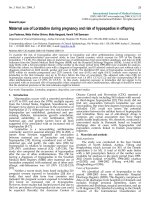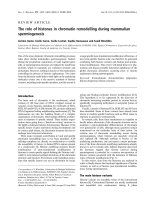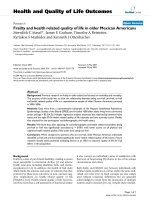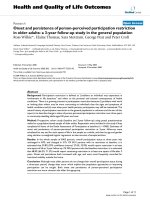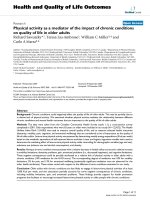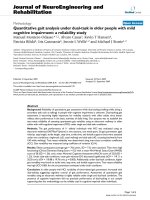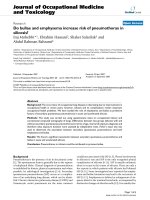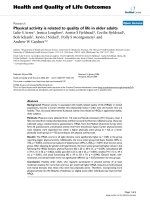Risk of falls in older people during fast walking – the TASCOG study
Bạn đang xem bản rút gọn của tài liệu. Xem và tải ngay bản đầy đủ của tài liệu tại đây (190.49 KB, 6 trang )
Gait & Posture 36 (2012) 510–515
Contents lists available at SciVerse ScienceDirect
Gait & Posture
journal homepage: www.elsevier.com/locate/gaitpost
Risk of falls in older people during fast-walking – The TASCOG study
M.L. Callisaya a,b,*, L. Blizzard b, J.L. McGinley c, V.K. Srikanth a,b
a
Stroke and Ageing Research Group, Department of Medicine, Southern Clinical School, Monash University, Victoria, Australia
Menzies Research Institute Tasmania, University of Tasmania, Tasmania, Australia
c
Physiotherapy – Melbourne School of Health Sciences, University of Melbourne, Victoria, Australia
b
A R T I C L E I N F O
A B S T R A C T
Article history:
Received 21 October 2011
Received in revised form 26 April 2012
Accepted 7 May 2012
Aims: To investigate the relationship between fast-walking and falls in older people.
Methods: Individuals aged 60–86 years were randomly selected from the electoral roll (n = 176). Gait
speed, step length, cadence and a walk ratio were recorded during preferred- and fast-walking using an
instrumented walkway. Falls were recorded prospectively over 12 months. Log multinomial regression
was used to estimate the relative risk of single and multiple falls associated with gait variables during
fast-walking and change between preferred- and fast-walking. Covariates included age, sex, mood,
physical activity, sensorimotor and cognitive measures.
Results: The risk of multiple falls was increased for those with a smaller walk ratio (shorter steps, faster
cadence) during fast-walking (RR 0.92, CI 0.87, 0.97) and greater reduction in the walk ratio (smaller
increase in step length, larger increase in cadence) when changing to fast-walking (RR 0.73, CI 0.63, 0.85).
These gait patterns were associated with poorer physiological and cognitive function (p < 0.05). A higher
risk of multiple falls was also seen for those in the fastest quarter of gait speed (p = 0.01) at fast-walking.
A trend for better reaction time, balance, memory and physical activity for higher categories of gait speed
was stronger for fallers than non-fallers (p < 0.05).
Conclusion: Tests of fast-walking may be useful in identifying older individuals at risk of multiple falls.
There may be two distinct groups at risk – the frail person with short shuffling steps, and the healthy
person exposed to greater risk.
ß 2012 Elsevier B.V. All rights reserved.
Keywords:
Gait
Falls
Fast-walking
Community-dwelling
Older person
1. Introduction
Up to 45% of older people living in the community fall annually
[1]. Falls can result in injury, loss of independence and death [2].
Risk factors for falls include poorer physiological and psychological
function [3]. It is desirable to be able to screen people in the
community who may require detailed assessment for risk of
falling. Gait patterns may provide valuable information toward
identifying people at risk, as poorer gait reflects a person’s inability
to compensate for decline in physiological and psychological
function [4].
A more cautious gait pattern, characterized by decreased speed
and step length [5], has been reported to be associated with falls
risk in hospitalized [6] and nursing home patients [7]. However,
evidence is equivocal as to whether such gait patterns predicts falls
[4,8] or not [9–13] in older people living in the wider community.
* Corresponding author at: Level 5, Block E, Monash Medical Centre, 246 Clayton
Road, Melbourne, Victoria 3168, Australia. Tel.: +61 3 6226 7700;
fax: +61 3 6226 7704.
E-mail addresses: ,
(M.L. Callisaya).
0966-6362/$ – see front matter ß 2012 Elsevier B.V. All rights reserved.
/>
Gait is often tested at a person’s preferred speed of walking, but
this may not be sufficiently sensitive to capture risk in such people.
Walking at a person’s fast speed (fast-walking) may place greater
demand on physiological and cognitive systems [14,15], and could
be more informative about falls risk. Furthermore those with a high
falls-risk may have greater difficulty increasing walking speed due
to greater levels of disability.
There have been few studies investigating falls-risk and fastwalking [16–18]. These studies have several limitations in that
samples of convenience with small subject numbers were used.
Moreover, these studies may have been affected by recall bias as a
result of adopting a method where falls were counted retrospectively. The results of these studies have also been conflicting. In one
study, people who fell had slower gait speed and cadence than
non-fallers [17], yet others report no differences in gait speed [16],
but faster cadence and shorter steps in fallers [18]. Therefore apart
from these individual gait measures, the pattern or combination of
step length and cadence used to increase speed may be an
important measure of falls risk. A persons walking pattern can be
summarized by the walk ratio (WR), calculated as step length
divided by cadence [19], whereby a lower ratio is the result of
shorter steps and/or a higher cadence.
M.L. Callisaya et al. / Gait & Posture 36 (2012) 510–515
The primary hypotheses of this prospective population-based
study were that those with: (1) poorer gait (slower speed, shorter
steps and a smaller WR) during fast-walking and (2) a smaller
change in gait from preferred- to fast-walking would have a greater
risk of falls. The secondary hypothesis was that poorer physiological
and psychological function would be associated with poorer gait at
fast-walking and with change between preferred- and fast-walking.
2. Materials and methods
2.1. Participants
Participants were drawn from the Tasmanian Study of Cognition and Gait
(TASCOG). Residents from southern Tasmania aged between 60 and 86 years (n = 412)
were randomly selected from the electoral roll. In this sub-study the first consecutive
176 participants were included. Participants were excluded if they lived in a highlevel care institution, were unable to walk without a gait aid, or if they had any
contraindication to MRI scan, as this was a requirement of the larger study. The
Southern Tasmanian Health and Medical Human Research Ethics Committee
approved this study and written consent was obtained from all participants.
2.2. Gait
A 4.6 m instrumented walkway system (GAITRite CIR systems, USA) was used to
measure gait speed and its determinants – step length and cadence. Participants
started 2 m before and finished 2 m after the mat to ensure a steady speed. The
average of six trials at both the preferred- and fast-walking tasks was used to
calculate each gait variable. The WR was calculated as step length divided by
cadence. The change in each gait variable between preferred- and fast-walking was
calculated as a percentage for gait speed, step length and cadence, while absolute
change was used for the WR.
2.3. Falls
Participants were sent a falls questionnaire every two months for 12 months to
report on incident falls defined as ‘an unexpected event in which the participant
comes to rest on the ground, floor or lower level’ [20]. They were also required to
complete a falls calendar during this time to assist in recollection of falls. Falls were
classified as either no, single or multiple falls (more than one fall).
2.4. Other measures
Self-reported medical history (arthritis, hypertension, diabetes mellitus, stroke,
lower-limb pain) was obtained using a questionnaire. Physiological factors
511
(reaction time, quadriceps strength, edge contrast sensitivity, proprioception and
balance) were measured using the protocols of the Physiological Profile Assessment
[21]. Cognitive function was assessed in four domains: executive function/attention –
Controlled Word Association Test [22], Category Fluency [22], the Victoria Stroop
test [23] and the Digit Span subtest of the Wechsler Adult Intelligence Scale (WIASIII) [24]; processing speed – Symbol Search and Digit Symbol Coding subtests of the
WAIS-III [24]; visuospatial ability – Rey Complex Figure copy task [22]; memory –
Hopkins Verbal Learning Test and a delayed reproduction after 20 min of the Rey
Complex Figure [22]. Mood was measured using the Geriatric Depression Scale
(short version). A summary cognitive component for each cognitive domain was
derived from the tests measuring that domain using principal components analysis
and regression scores were generated for each component using Thomson’s method
for use in further analysis [25]. For physical activity, the average number of steps
per day was measured using a Yamax Digi-Walker SW-200 pedometer worn for 7
days [26]. Self-reported medical history was obtained from those who declined to
participate (non-responders) by telephone interview.
2.5. Statistical analysis
Responders and non-responders were compared using chi-squared analysis and
t-tests. Pearson correlations adjusted for age, sex, height and weight (partial
correlations) were estimated between physiological or cognitive variables and gait
measures. Log multinomial regression was used to estimate risk and relative risk of
single and multiple falls. This model is used to obtain relative risk estimates for
nominal outcomes with more than two attributes [27]. The initial model was
adjusted for age, sex, height and weight. Further adjustment was made for
physiological or cognitive factors if a variable changed the coefficient of the gait
variable by more than 10%. Quadratic trend was assessed by adding a square of the
variable and testing its significance. Gait variables were categorized into quarters to
further examine quadratic relationships, where the relative risk is the proportion of
subjects with multiple falls at one of the gait measure relative to the proportion of
subjects with multiple falls in the reference (first quarter) of the gait measure.
Means of all covariates are presented stratified by categories of gait speed, and tests
of trend and interaction with falls were assessed using linear regression. Data were
analyzed using STATA version 10.1 (StataCorp, Texas, USA).
3. Results
The participant response proportion in the overall study was
51% (412/804). Responders were younger (p = 0.01) and had a
lower self-reported history of hypertension (p = 0.03). There were
no significant differences between the full sample and the 176
participants in this sub-study with respect to age, sex, height,
Table 1
Sample characteristics (n = 176).
Characteristic
Lost to follow up
n = 21
No falls
n = 85
Single fall
n = 42
Multiple falls
n = 28
Included in analysis
n = 155
Age, mean (SD)
Sex (% male)
Height, cm (SD)
Weight, cm (SD)
Medical history
(self-reported), n (%)
Arthritis
Hypertension
Diabetes
Stroke
Gait measures, mean (SD)
Preferred walking speed
Gait speed, m/s
Cadence, steps/min
Step length, cm
Walk ratio
Fast walking speed
Gait speed, m/s
Cadence, steps/min
Step length, cm
Walk ratio
Change from preferredto fast-walking
Gait speed, %
Cadence, %
Step length, %
Walk ratio
74.5 (6.6)
57.1
167.8 (8.5)
81.3 (19.2)
71.5 (6.8)
56.5
166.1 (7.8)
74.7 (14.3)
72.9 (5.8)
52.4
165.7 (9.1)
77.2 (14.3)
75.7 (8.5)
50.0
165.1 (9.1)
73.7 (11.3)
72.6 (7.0)
54.2
165.8 (8.0)
75.2 (13.8)
Note: SD, standard deviation.
11
9
4
1
(52.4)
(42.9)
(19.1)
(4.8)
31
37
9
5
(36.90)
(43.5)
(10.6)
(5.9)
21
23
7
3
(51.2)
(54.8)
(16.7)
(7.1)
11
13
2
4
(39.3)
(46.4)
(7.1)
(14.3)
63
73
18
12
(41.2)
(47.1)
(11.6)
(7.7)
1.08 (0.21)
111.5 (10.1)
58.1 (9.1)
0.52 (0.08)
1.14 (0.19)
110.3 (9.7)
62.0 (8.0)
0.56 (0.08)
1.11 (0.17)
109.2 (9.4)
60.9 (8.0)
0.56 (0.09)
1.12 (0.26)
112.3 (11.3)
59.7 (10.1)
0.53 (0.09)
1.13 (0.20)
110.3 (9.9)
61.3 (8.4)
0.56 (0.09)
1.45 (0.30)
131.3 (13.2)
66.3 (11.7)
0.51 (0.10)
1.59 (0.28)
132.4 (15.2)
71.9 (10.2)
0.55 (0.11)
1.54 (0.30)
133.0 (16.7)
69.5 (10.4)
0.53 (0.10)
1.51 (0.37)
137.3 (19.9)
66.0 (12.2)
0.49 (0.11)
1.56 (0.30)
133.5 (16.5)
70.2 (10.8)
0.53 (0.11)
34.3 (10.3)
17.8 (6.1)
13.9 (6.5)
À0.02 (0.04)
39.8 (17.7)
20.2 (10.5)
16.0 (7.2)
À0.02 (0.05)
38.7 (14.3)
21.7 (10.1)
13.9 (6.0)
À0.03 (0.05)
34.7 (13.5)
22.1 (10.8)
10.4 (7.2)
À0.05 (0.05)
38.6 (16.2)
21.0 (10.4)
14.4 (7.2)
À0.03 (0.05)
M.L. Callisaya et al. / Gait & Posture 36 (2012) 510–515
512
Table 2
Partial correlations between gait variables and covariates adjusted for age, sex, height and weight (n = 155).
Change from preferred- to fast-walking
Fast-walking
Quadriceps strength
Reaction time
Proprioception
ECS
Balance eyes open
Balance eyes closed
Lower limb pain
Mood
Memory
Visuospatial ability
EF/attention
Processing speed
Physical activity
Gait speed
Step length
Cadence
Walk ratio
Gait speed
Step length
Cadence
Walk ratio
0.31*
À0.21y
À0.06
0.06
À0.17z
À0.21z
À0.1
À0.17z
0.24y
0.22y
À0.28*
0.30*
0.18z
0.27y
À0.20z
À0.03
À0.01
À0.21z
À0.23y
À0.17z
À0.18z
0.17z
0.15
À0.23y
0.24y
0.21z
0.23y
À0.15
À0.04
0.08
À0.05
À0.09
0.00
À0.07
0.19z
0.21z
À0.21z
0.23y
0.10
0.05
À0.05
0.02
À0.07
À0.13
À0.12
À0.12
À0.07
À0.02
À0.02
À0.02
0.01
0.13
0.14
À0.02
0.06
0.04
0.01
À0.02
0.03
0.02
0.17z
0.13
À0.13
0.24y
À0.00
0.16
0.01
0.06
0.06
0.10
0.01
À0.04
À0.02
0.05
À0.00
À0.02
0.11
À0.02
0.08
À0.03
0.04
0.02
À0.04
À0.03
0.07
0.04
0.20z
0.19z
À0.17z
0.25y
0.01
0.06
0.04
0.03
À0.01
0.12
0.08
À0.09
À0.03
À0.17z
À0.17z
0.17z
À0.16z
À0.01
ECS, edge contrast sensitivity; EF, executive function. All models were adjusted for age, sex, height and weight. Higher scores of memory, spatial ability and processing speeds
and lower scores of executive function/attention indicate better function.
*
p < 0.001.
y
p < 0.01.
z
p < 0.05.
with reports of pain (p < 0.05). The WR was not associated with
any of the covariates. A smaller change in gait speed from
preferred- to fast-walking was associated with poorer memory and
processing speed (p < 0.05). A smaller change in cadence and the
WR were associated with poorer memory, processing speed,
spatial ability and executive function (p < 0.05).
weight or self-reported medical history (p > 0.05). If participants
had not completed all six questionnaires and had not reported a
fall (n = 21), they were recorded as lost to follow-up, leaving 155
participants (88.1%) for analysis. Forty five percent (27% single
fall, 18% multiple falls) of participants reported at least one fall in
the follow-up period. Table 1 provides baseline characteristics
for those lost to follow up, those with no falls, single falls and
multiple falls. There were no significant differences between
those lost to follow-up and those included in the analyses
(p > 0.05).
3.2. Gait and risk of falls
Table 3 presents the relative risk of each gait measure with
single and multiple falls. None of the gait measures was associated
with the risk of single falls. The following results describe the
associations between gait measures and multiple falls.
3.1. Correlations between physical function, psychological function
and gait variables
Table 2 provides the correlations between mood, physical
activity, physiological and cognitive function and gait variables.
During fast-walking, slower gait speed, shorter steps and a slower
cadence were associated with poorer quadriceps strength,
memory, processing speed and executive function (p < 0.05).
Slower gait speed and shorter steps were associated with poorer
reaction time, balance, mood and physical activity. Slower speed
was also associated with poorer spatial ability, and shorter steps
3.3. Fast-walking
During fast-walking, after initial adjustment for age, sex, height
and weight (Model 1), the risk of falls was associated with a faster
cadence (p = 0.04) and a lower WR (p = 0.04). Further adjustment
for physiological and psychological factors (Model 2) increased the
strength of the association for cadence (p = 0.004), and the WR
(p = 0.002). In addition a shorter step length (p = .046) was
Table 3
Adjusted association of average measures of gait with single and multiple falls (n = 155).
One fall
Multiple falls
Model 1
Model 2
Model 1
Model 2
RR 95% CI
RR 95% CI
RR 95% CI
RR 95% CI
Fast-walking
1.00 (0.99, 1.01)
Gait speed, cm/s
Cadence, steps/min
1.00 (0.98, 1.02)
Step length, cm
1.00 (0.97, 1.04)
Walk ratio
1.01 (0.98, 1.04)
Change from preferred- to fast-walking
Gait speed, %
1.00 (0.99, 1.02)
Cadence, %
1.01 (0.98, 1.03)
Step length, %
0.99 (0.95, 1.03)
Walk ratio
0.97 (0.92, 1.02)
1.00
0.99
1.00
1.01
(0.99,
(0.96,
(0.97,
(0.98,
1.01)
1.01)
1.03)
1.05)
1.00
1.02
0.98
0.96
(0.99,
(1.00,
(0.95,
(0.93,
1.01)
1.05)
1.01)
0.99)
1.01
1.09
0.95
0.92
(0.99,
(1.03,
(0.89,
(0.87,
1.03)
1.16)
0.99)
0.97)
0.99
1.00
0.99
0.98
(0.98,
(0.97,
(0.95,
(0.92,
1.01)
1.03)
1.04)
1.04)
0.99
1.01
0.93
0.93
(0.96,
(0.98,
(0.88,
(0.88,
1.01)
1.04)
0.97)
0.99)
0.98
1.05
0.55
0.73
(0.94,
(1.01,
(0.36,
(0.63,
1.02)
1.10)
0.84)
0.85)
Notes: RR, relative risk; CI, confidence interval; walk ratio was multiplied by 100.
Model 1 adjusted for age, height, weight and sex.
Model 2 adjusted for age, height, weight, sex and additionally for other sensorimotor and cognitive measures as outlined below:
Gait speed: quadriceps strength, reaction time, mood, executive function and processing speed.
Step length: quadriceps strength, reaction time, proprioception, lower limb pain, mood, memory, executive function and processing speed.
Cadence: executive function, mood, reaction time, balance eyes closed, processing speed and memory.
Walk ratio: quadriceps strength, reaction time, lower limb pain and mood.
M.L. Callisaya et al. / Gait & Posture 36 (2012) 510–515
513
Table 4
Adjusted association of measures of gait with multiple falls (n = 155).
Fast-walking speed (cm/s)
1st quarter (65.4–139.6)
2nd quarter (139.7–154.4)
3rd quarter (154.5–175.5)
4th quarter (175.6–260.2)
p-Value for quadratic trend
Step length (cm)
1st quarter (34.2–62.9)
2nd quarter (63.0–71.3)
3rd quarter (71.3–77.8)
4th quarter (77.9–107.0)
p-Value for quadratic trend
No falls
Single falls
Multiple falls
n (%)
n (%)
n (%)
RR (95% CI)
16
24
23
22
(41.0)
(61.5)
(59.0)
(57.9)
12
10
12
8
(30.8)
(25.7)
(30.8)
(21.1)
11
5
4
8
(28.2)
(12.8)
(10.3)
(21.05)
1.00
0.77 (0.22, 2.64)
0.93 (0.24, 3.56)
2.75 (0.44, 17.13)
0.01
11
25
27
22
(28.2)
(64.1)
(69.2)
(57.9)
15
10
7
10
(38.5)
(25.6)
(18.0)
(26.3)
13
4
5
6
(19.8)
(10.3)
(12.8)
(15.8)
1.00
0.03 (0.00, 0.41)
0.02 (0.00, 0.32)
0.07 (0.01, 0.72)
0.01
Notes: RR, relative risk; CI, confidence interval. Models adjusted as per Model 2 in Table 3.
Table 5
Mean (SD) of sensorimotor, cognitive and physical activity stratified by quarters of gait speed (fast pace).
Q2
Q1
Quadriceps strength, kg
Reaction time, ms
Proprioception, degrees
ECS, dB
Balance eyes open, mm
Balance eyes closed, mm
Lower limb pain, n (%)
Mood
Memory
Visuospatial ability
EF/attention
Processing speed
Physical activity, steps/day
Q3
Q4
Trend
Mean
(SD)
Mean
(SD)
Mean
(SD)
Mean
(SD)
p value
25.4
257.4
1.4
19.7
28.7
68.2
19
2.8
À0.51
30.7
1.3
À0.9
4302.3
(8.4)
(76.5)
(1.0)
(2.2)
(31.8)
(66.7)
(48.7)
(2.6)
(1.96)
(5.4)
(2.5)
(1.2)
(3260.6)
30.9
227.7
1.2
20.6
21.7
42.6
20
1.6
À0.29
32.9
0.1
À0.1
5092.8
(9.6)
(33.4)
(1.1)
(1.9)
(9.6)
(31.1)
(51.3)
(1.4)
(1.21)
(4.0)
(1.9)
(1.2)
(2515.1)
31.1
222.6
1.3
20.9
22.7
36.0
10
1.9
0.32
33.2
À0.7
0.3
6586.6
(9.1)
(22.4)
(1.0)
(1.9)
(7.3)
(13.5)
(25.6)
(2.4)
(1.09)
(3.7)
(1.0)
(1.1)
(3510.3)
38.8
213.1
1.1
20.9
19.9
36.9
10
1.0
0.73
34.1
À0.7
0.7
7435.7
(12.4)
(29.0)
(1.0)
(2.4)
(5.8)
(15.5)
(26.3)
(1.9)
(1.36)
(2.3)
(1.3)
(1.3)
(2762.1)
<0.001
<0.001
0.39
0.007
0.05
<0.001
0.008
0.001
<0.001
<0.001
<0.001
<0.001
<0.001
Notes. SD, standard deviation; Q, quarter. Better function is represented by higher scores for quadriceps strength, ECS, memory, visuospatial ability, processing speed and
physical activity.
associated with increased risk of falls. Tests of quadratic trend
(Table 4) were significant for gait speed (p = 0.01) and step length
(p = 0.01). The highest risk of falls was for those in the fastest
quarter of gait speed.
3.4. Change in gait from preferred- to fast-walking
In Model 1 risk of falls was increased in those with a smaller
change in step length (p = 0.02) and greater reduction in the WR
(p = 0.001). In Model 2 there was a significant increase in risk of
multiple falls for those with greater change in cadence (p = 0.009),
smaller change in step length (p = 0.006) and greater reduction in
the WR (p = 0.003). Change in gait speed was not associated with
risk of falls (p = 0.94).
Further analysis was undertaken to investigate possible
mechanisms for the increased risk of falls in the highest quarter
of gait speed. Table 5 provides the means of each physiological and
cognitive variable by quarters of gait speed. Other than for
proprioception, there was a significant trend for better performance in all covariates with higher category of gait speed. For
reaction time (p = 0.04), balance eyes open (p = 0.01), memory
(p = 0.04) and physical activity (p = 0.02), the trend for better
performance was stronger for fallers than non-fallers. The means of
these variables further stratified by falls are provided in Table 6
(Supplementary data). For balance eyes open (p = 0.02) and
memory (p = 0.03), the difference in means between non-fallers
and fallers was reversed in the fourth quarter with fallers having
better memory and balance.
4. Discussion
In this population-based study of older people the risk of
multiple falls was increased in those with a lower WR during fastwalking and a greater reduction in the WR from preferred- to fastwalking. In addition, there was increased risk in those walking in
the slowest and fastest quarters of gait speed during the fastwalking task, suggesting well-functioning older people may also be
at greater risk of falling. These results support measuring gait at
fast-walking speeds in order to identify those at risk of multiple
falls.
During fast-walking, the increased risk of multiple falls in those
with a smaller WR (e.g. every 1 unit decrease in the WR was
associated with an 8% increased risk) was due to smaller steps and
a faster cadence. Similarly, increased risk in those with greater
reductions in the WR from preferred- to fast-walking was due to
smaller increases in step length and larger increases in cadence.
Although a quadratic trend was significant for step length at fastwalking, examination of quarters showed that essentially there
was minimal risk of falls for those in the second, third and fourth
quarters. No previous studies to our knowledge have examined the
associations between the WR and falls risk. However, in support of
our findings a previous study reported fallers walked with smaller
steps and a faster cadence compared with non-fallers at selected
speeds on a treadmill [18]. In contrast, Newstead et al. reported
that in a sample of healthy older volunteers walking at fast speed,
fallers had a slower cadence but similar step lengths compared
with non-fallers [17]. Differences with this study may be due to
514
M.L. Callisaya et al. / Gait & Posture 36 (2012) 510–515
differing sample selection. Our results build on the work of others
who have suggested walk ratios may be a useful and reliable
measure for assessing older people with impaired gait [19].
Although cross-sectional, our results suggest smaller steps
during fast-walking are a marker of poorer sensorimotor and
cognitive function, impairments that are also associated with falls
[28]. In contrast, a higher cadence at fast-walking and greater
change in cadence was associated with better cognitive function
and quadriceps strength (fast-walking only). This suggests higher
cadence may not necessarily indicate poorer function, but may be
an adaptive strategy to spend less time in the unstable single
support phase of gait or used as an alternative to increasing step
length when asked to walk faster. Such a gait pattern of short steps
and a high cadence may increase the chance of tripping [29].
This study had a number of negative findings. Firstly, none of
the gait measures were associated with single falls. This is in
agreement with others who have suggested single falls may not be
due to physiological impairments [30] that impact on gait.
Secondly, gait speed was not linearly associated with risk of falls,
possibly due to opposing directions of associations between its
determinants and falls. However, similar to our previous study at
preferred speed [13], there was evidence that those with walking
speeds in the slowest and fastest quarter were at increased risk of
falls (Table 4). Those in the fastest quarter had the highest risk and
these individuals performed better on memory and balance tests
suggesting that they may be highly functioning individuals.
Although we did not have information regarding whether these
people fell whilst engaging in vigorous activities, we did identify
that there was a stronger trend for greater physical activity for each
quarter of gait speed for fallers, perhaps exposing them to a greater
risk of falling. Alternatively, previous studies have identified that
some people underestimate their falls risk [1]. Those who
underestimate falls risk may increase gait speed to levels that
are too fast for their ability [31]. However, in a recent study of older
people at physiological risk of falling, a low perceived falls risk
seemed to be protective against future falls [1]. Further research is
required to unravel the relationship between gait speed, perceived
falls risk and future falls.
Our findings support using fast-walking as a simple and
challenging test to identify falls risk in community-settings.
Although in this study step length and cadence were collected on
the GaitRite mat, they can be collected inexpensively using a
measured distance on the floor and a stop watch. Our results
indicate that targeting factors such as pain, mood, physical activity,
physiological and cognitive function may improve gait patterns
during fast-walking. Our results also suggest a second highfunctioning group of older people at risk of falling, perhaps due to
engagement in higher activity levels. Although it may not be
beneficial to recommend reducing activities in this group,
assessment needs to be made to ensure sufficient balance and
cognitive function for selected activities and sufficient vitamin D
and bone density levels to reduce the risk of fractures.
There are several strengths to this study. It is the first
population-based study to examine associations between tests
of fast-walking and falls risk and we included gait measures other
than speed such as its determinants – step length, cadence and the
WR. We used a prospective design for falls collection limiting recall
bias, carefully examined for non-linear association and adjusted
for a large number of potential confounders. Although this study
was more generalizable to the wider population of older people it
is possible that there was some bias due to selection or drop out.
Participants were included only if they could walk without the use
of a gait aid, possibly resulting in a healthier sample than the
general population. The response rate was moderate and a number
of participants did not complete the falls follow-up. However,
there was no difference between those who did and did not
complete follow-up. Finally, it would be interesting to compare
fast-walking with other challenging tests (such as dual-task
activities) in predicting falls risk and to investigate the role of
self-efficacy in ability to change walking speeds.
4.1. Summary
Gait measured during fast-walking may provide a useful falls
screening test. Risk of multiple falls was increased in tests of fastwalking in those with a smaller WR and slowest gait speeds, and in
those with a greater reduction in the WR from preferred- to fastwalking. In addition, those walking in the fastest quarter of gait
speed during fast-walking were also at increased risk perhaps due
to engagement in greater levels of activity, suggesting two distinct
groups at risk of falls.
Funding
This work was supported by the National Health and Medical
Research Council (grant number 403000 BH); Physiotherapy
Research Foundation (grant number BH036/05); Perpetual Trustees; Brain Foundation; Royal Hobart Hospital Research Foundation (grant number 341M); ANZ Charitable Trust and Masonic
Centenary Medical Research Foundation.
Conflict of interest statement
There are no conflicts of interest.
Appendix A. Supplementary data
Supplementary data associated with this article can be found,
in the online version, at />2012.05.003.
References
[1] Delbaere K, Close JC, Brodaty H, Sachdev P, Lord SR. Determinants of disparities
between perceived and physiological risk of falling among elderly people:
cohort study. BMJ 2010;341:c4165.
[2] Campbell AJ, Borrie MJ, Spears GF, Jackson SL, Brown JS, Fitzgerald JL. Circumstances and consequences of falls experienced by a community population 70
years and over during a prospective study. Age and Ageing 1990;19(March
(2)):136–41.
[3] American Geriatrics Society, British Geriatrics Society, American Academy of
Orthopaedic Surgeons Panel on Falls Prevention. Guideline fo the prevention of
falls in older people. Journal of American Geriatric Society 2001;49:664–72.
[4] Tiedemann A, Sherrington C, Lord SR. Physiological and psychological predictors of walking speed in older community-dwelling people. Gerontology
2005;51(November–December (6)):390–5.
[5] Giladi N, Herman T, Reider II G, Gurevich T, Hausdorff JM. Clinical characteristics of elderly patients with a cautious gait of unknown origin. Journal of
Neurology 2005;252(March (3)):300–6.
[6] Guimaraes RM, Isaacs B. Characteristics of the gait in old people who fall.
International Rehabilitation Medicine 1980;2(4):177–80.
[7] Wolfson L, Whipple R, Amerman P, Tobin JN. Gait assessment in the elderly: a
gait abnormality rating scale and its relation to falls. Journals of Gerontology
1990;45(January (1)):M12–9.
[8] Verghese J, Holtzer R, Lipton RB, Wang C. Quantitative gait markers and
incident fall risk in older adults. The Journals of Gerontology Series A Biological
Sciences and Medical Sciences 2009;64(August (8)):896–901.
[9] Lord SR, Lloyd DG, Li SK. Sensori-motor function, gait patterns and falls in
community-dwelling women. Age and Ageing 1996;25(July (4)):292–9.
[10] Hill K, Schwarz J, Flicker L, Carroll S. Falls among healthy, community-dwelling, older women: a prospective study of frequency, circumstances, consequences and prediction accuracy. Australian and New Zealand Journal of
Public Health 1999;23(February (1)):41–8.
[11] Hausdorff JM, Rios DA, Edelberg HK. Gait variability and fall risk in community-living older adults: a 1-year prospective study. Archives of Physical Medicine and Rehabilitation 2001;82(August (8)):1050–6.
[12] Maki BE. Gait changes in older adults: predictors of falls or indicators of fear.
Journal of the American Geriatrics Society 1997;45(March (3)):313–20.
M.L. Callisaya et al. / Gait & Posture 36 (2012) 510–515
[13] Callisaya M, Blizzard L, Schmidt MD, Martin K, McGinley JL, Sanders L, et al.
Gait, gait variability and the risk of multiple incident falls in older people—a
population-based study. Age and Ageing 2011;40(4):481–7.
[14] Deshpande N, Metter EJ, Bandinelli S, Guralnik J, Ferrucci L. Gait speed under
varied challenges and cognitive decline in older persons: a prospective study.
Age and Ageing 2009;38(September (5)):509–14.
[15] Ko SU, Stenholm S, Chia CW, Simonsick EM, Ferrucci L. Gait pattern alterations
in older adults associated with type 2 diabetes in the absence of peripheral
neuropathy—results from the Baltimore Longitudinal Study of Aging. Gait &
Posture 2011;34(October (4)):548–52.
[16] Shumway-Cook A, Baldwin M, Polissar NL, Gruber W. Predicting the probability for falls in community-dwelling older adults. Physical Therapy
1997;77(August (8)):812–9.
[17] Newstead AH, Walden JG, Gitter AJ. Gait variables differentiating fallers from
nonfallers. Journal of Geriatric Physical Therapy 2007;30(3):93–101.
[18] Barak Y, Wagenaar RC, Holt KG. Gait characteristics of elderly people with a
history of falls: a dynamic approach. Physical Therapy 2006;86(November
(11)):1501–10.
[19] Nagasaki H, Itoh H, Hashizume K, Furuna T, Maruyama H, Kinugasa T. Walking
patterns and finger rhythm of older adults. Perceptual and Motor Skills
1996;82(April (20)):435–47.
[20] Lamb SE, Jorstad-Stein EC, Hauer K, Becker C. Development of a common
outcome data set for fall injury prevention trials: the Prevention of Falls
Network Europe consensus. Journal of the American Geriatrics Society
2005;53(September (9)):1618–22.
[21] Lord SR, Menz HB, Tiedemann A. A physiological profile approach to falls risk
assessment and prevention. Physical Therapy 2003;83(March (3)):237–52.
515
[22] Lezak M. Neuropsychological Assessment, third ed., New York: Oxford University Press; 1995.
[23] Spreen O, Strauss E. A Compendium of Neuropsychological Tests. Administration, Norms, and Commentary, 2nd ed., New York: Oxford University Press; 1998
.
[24] Wechsler D. Wechsler Adult Intelligence Scale. New York, NY: Psychological
Corporation; 1997.
[25] Martin K, Thomson R, Blizzard L, Wood A, Garry M, Srikanth V. Visuospatial
ability and memory are associated with falls risk in older people: a populationbased study. Dementia and Geriatric Cognitive Disorders 2009;27(5):451–7.
[26] Bassett Jr DR, Ainsworth BE, Leggett SR, Mathien CA, Main JA, Hunter DC, et al.
Accuracy of five electronic pedometers for measuring distance walked. Medicine and Science in Sports and Exercise 1996;28(August (8)):1071–7.
[27] Blizzard L, Hosmer DW. The log multinomial regression model for nominal
outcomes with more than two attributes. Biometrical Journal 2007;49
(December (6)):889–902.
[28] Lord SR, Clark RD, Webster IW. Physiological factors associated with falls in an
elderly population. Journal of the American Geriatrics Society 1991;39
(December (12)):1194–200.
[29] Pavol MJ, Owings TM, Foley KT, Grabiner MD. Gait characteristics as risk factors
for falling from trips induced in older adults. The Journals of Gerontology Series A
Biological Sciences and Medical Sciences 1999;54(November (11)):M583–90.
[30] Lord SR, Ward JA, Williams P, Anstey KJ. Physiological factors associated with
falls in older community-dwelling women. Journal of the American Geriatrics
Society 1994;42(October (10)):1110–7.
[31] van Iersel MB, Verbeek AL, Bloem BR, Munneke M, Esselink RA, Rikkert MG.
Frail elderly patients with dementia go too fast. Journal of Neurology Neurosurgery and Psychiatry 2006;77(July (7)):874–6.
